Determining Your Audiences For Your Software or Technology Website
Imagine casting a net into the vast ocean of the internet, hoping to capture a handful of valuable leads. Without a clear understanding of who those leads are, you’re essentially leaving your success to chance. This is where the concept of identifying SaaS target audiences steps in.
By meticulously pinpointing your potential customers, you can tailor your strategies, messages, and products to meet their needs directly. This improves your chances of capturing their attention and enhances their overall experience with your brand.
Let’s explore the steps to effectively determine the target audiences for your SaaS website.
The Significance of Defining Target Audiences
In the dynamic realm of SaaS, the significance of identifying and understanding your target audiences cannot be overstated. This industry is also extremely saturated, with a variety of solutions at customers’ fingertips. You need to decipher the target persona that would benefit the most from your product.
According to SEMrush, 45% of marketers say that attracting quality leads with their content is a top challenge for them. This is why doing your best to narrow down your target customers is key.
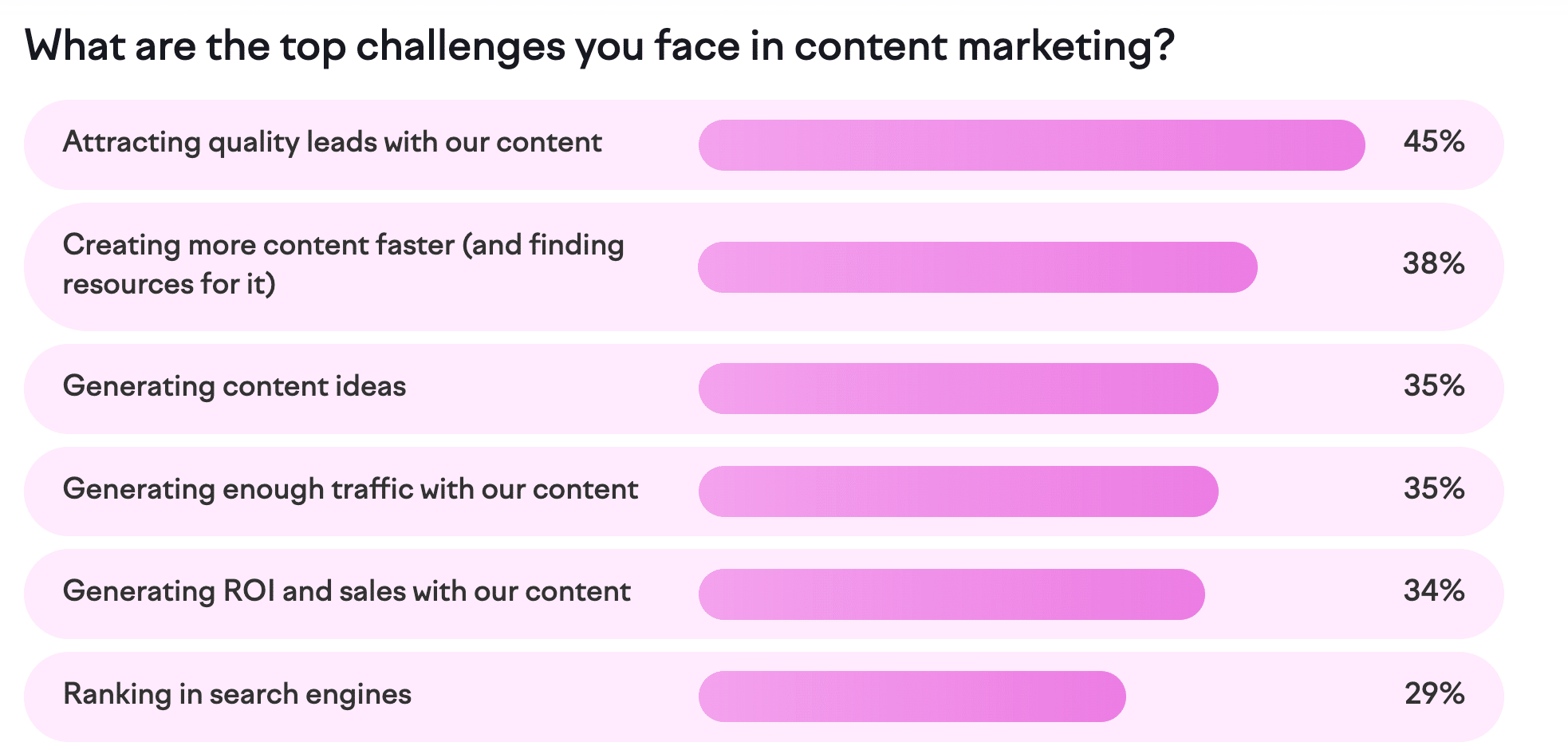
Efficient Resource Allocation & Focused Marketing Efforts
In a world where time and resources are precious commodities, the ability to allocate them strategically is vital. By defining your target audiences, you gain the advantage of directing your efforts precisely where they’ll yield the most impact. This translates to more efficient marketing campaigns, optimized messaging, and the ability to connect with individuals who are most likely to engage with your offerings.
Imagine a scenario where you’re launching a new SaaS solution designed to streamline project management for small businesses. By identifying your audience as entrepreneurs, managers, and decision-makers in this specific niche, you can channel your resources into channels that resonate with them. This not only saves you from the shotgun approach of generic marketing but also allows you to build rapport with potential customers by addressing their pain points directly.
Tailoring Product Offerings & Messaging
One size doesn’t fit all—especially in the diverse world of SaaS and tech. Each audience segment has its unique set of needs, preferences, and aspirations. By accurately defining your target audiences, you can tailor your product offerings and messaging to align with their expectations.
Consider a scenario where your tech startup develops both a high-powered analytics tool for enterprises and a simplified version for startups. By recognizing the distinct requirements of these two segments and customizing your product features accordingly, you can increase the likelihood of striking a chord with both types of customers. This personalization breeds authenticity, trust, and loyalty—a trifecta that’s crucial in a competitive market.
Enhancing User Experience Through Personalized Content
User experience (UX) reigns supreme in the tech industry. Today’s users are not only tech-savvy but also discerning, expecting interactions that cater to their individual preferences. Defining your target audiences enables you to offer personalized content and features that speak directly to their needs, enriching their interactions with your website, applications, and services.
Imagine a SaaS company that provides a comprehensive suite of e-commerce tools. By segmenting its target audiences into small e-commerce businesses and established online retailers, the company can offer tailored guides, case studies, and tools that address the unique challenges faced by each group. This level of personalization not only improves user satisfaction but also positions your brand as a trusted partner invested in your customers’ success.
Steps to Determine Target Audiences
Navigating the intricate landscape of SaaS and tech requires a systematic approach to identifying your target audiences.
Step 1: Market Research & Analysis
Identify Industry Trends & Market Demands
Stay attuned to industry trends, emerging technologies, and evolving market demands. This involves monitoring shifts in user behaviors, technological advancements, and areas where gaps exist in the current market offerings. By identifying these trends, you can tailor your strategies to meet the changing needs of your audience.
Analyze Competitors & Their Customer Profiles
Study your competitors’ strengths, weaknesses, and the segments they’re serving. Analyzing their customer profiles can provide insights into the types of audiences that resonate with their offerings. This information can serve as a starting point for defining your own target audiences, while also identifying gaps that your products or services could address more effectively.
Insivia recently launched a Competitor Comparison tool on our Frictionless platform. You can try it out for yourself for free. See for yourself how easy it is to conduct and organize your competitor research.
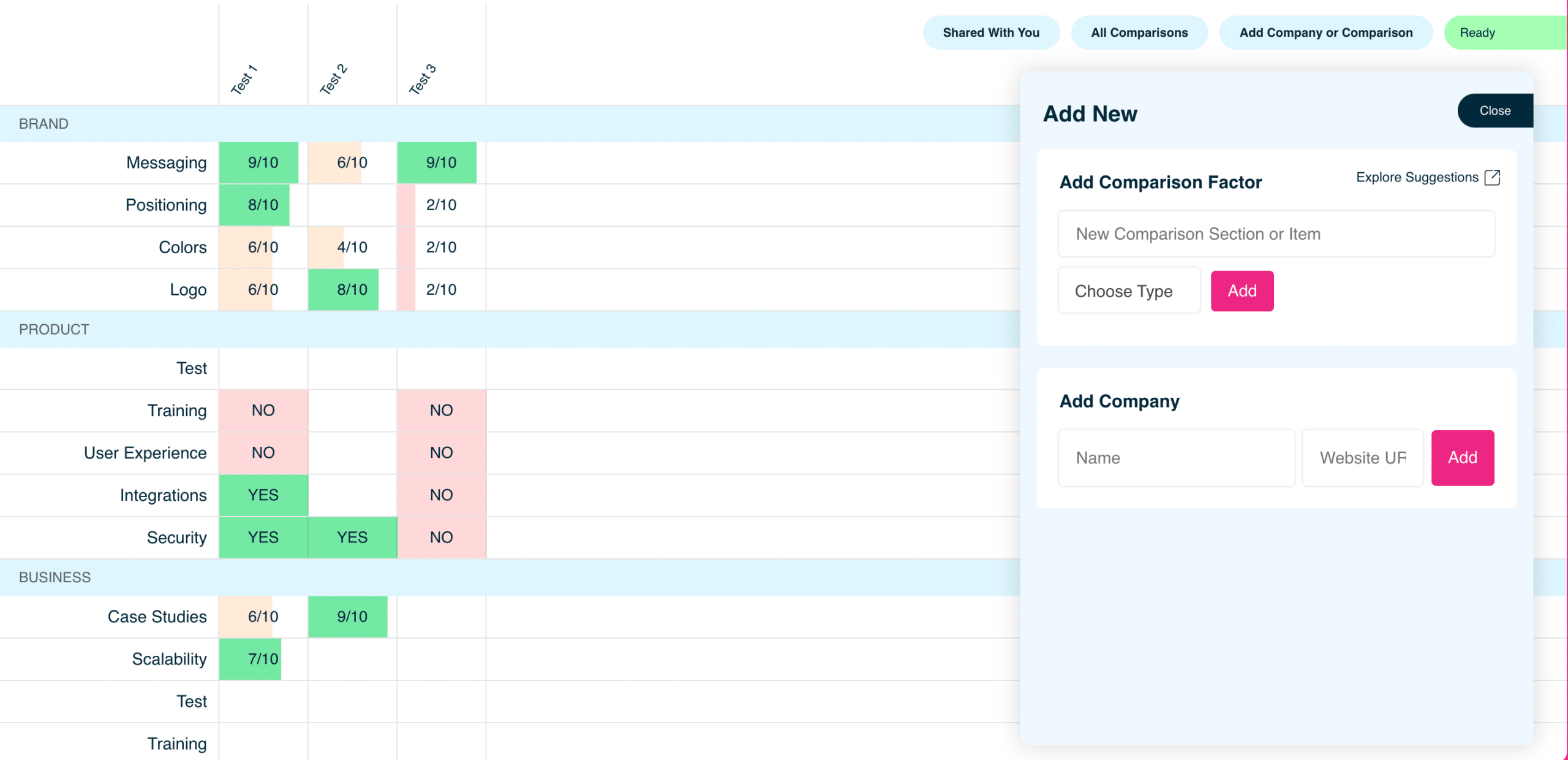
Conduct Surveys, Interviews, and Focus Groups
Engage directly with your current customers and potential leads through surveys, interviews, and focus groups. These methods provide valuable qualitative insights into their preferences, pain points, and aspirations. You can gather firsthand feedback on what they value in a SaaS or tech solution and how your offering aligns with their needs. This firsthand information is gold when crafting your target audience profiles.
By combining insights from industry trends, competitor analysis, and direct customer interactions, you create a robust foundation for understanding your potential target audiences.
Step 2: Creating Buyer Personas
After conducting thorough market research and analysis, the next pivotal step in determining your target customers for SaaS and tech websites is creating buyer personas. In fact, customer-centric companies are 60% more profitable than companies that are not customer-centric.
Buyer personas are detailed, semi-fictional representations of your ideal customers, helping you understand their needs, behaviors, and preferences. This step enables you to align your strategies with real-world individuals, guiding your marketing, product development, and user experience efforts.
Define Characteristics of Ideal Customers
To create accurate and impactful buyer personas, you need to clearly define the characteristics of your ideal customers. Start by examining the insights gathered from your market research and competitor analysis. Look for common traits among the users who would benefit most from your offerings.
Consider factors such as job roles, industries, company sizes, and pain points that your products or services address. For instance, if you offer a cybersecurity solution, your ideal customers might include IT managers in medium-sized enterprises looking to bolster their data security.
Include Demographic, Psychographic, & Behavioral Traits
A well-rounded buyer persona encompasses a range of traits that shed light on your audience’s motivations, preferences, and decision-making processes.
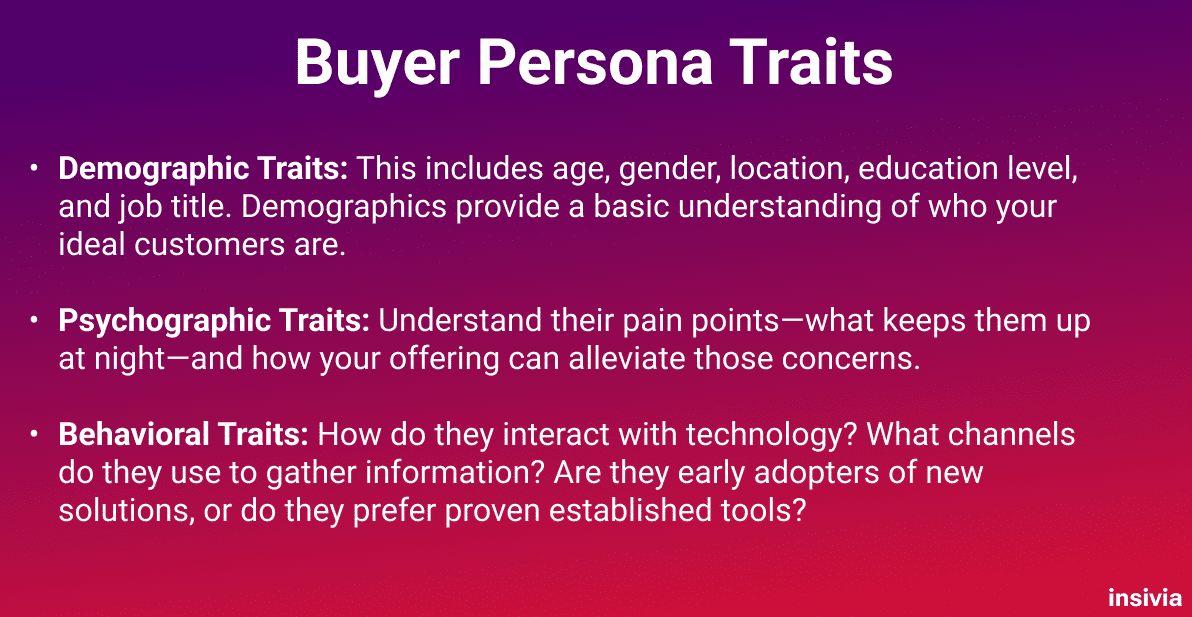
Building Multiple Personas for Different Segments
You’ll likely have various segments within your target audience, each with distinct needs and expectations. Building multiple personas allows you to create tailored strategies for each segment.
For instance, if you offer project management software, your segments might include startup founders, mid-level managers in established companies, and freelancers. Each of these segments would have different priorities. Startups might focus on affordability, managers on scalability, and freelancers on ease of use.
To build personas, use a mix of quantitative data from surveys and qualitative insights from customer interviews. Craft narratives that humanize your personas, going beyond mere statistics to create relatable characters. Give them names, personalities, and backstories. This human-centric approach makes it easier for your team to empathize with your target audiences and make strategic decisions that align with their needs.
If you need assistance with establishing your target buyer personas, our Frictionless platform is the perfect solution for that. We’ve specifically developed an AI Persona Builder that helps you narrow down the target markets your business needs to aim towards.
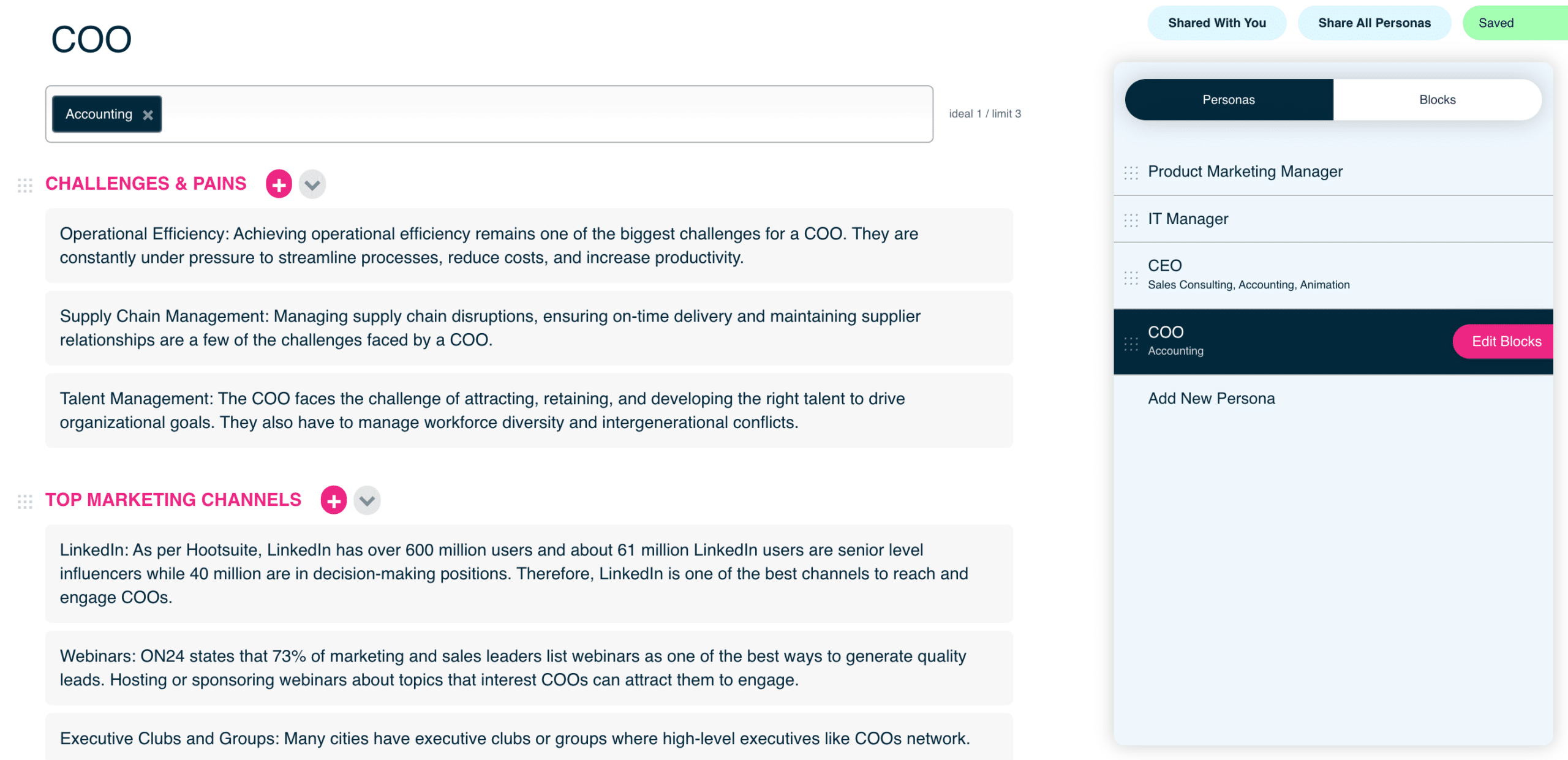
Explore this tool for yourself today and improve your marketing strategy with your ideal customer profiles.
Step 3: Analyzing User Data
With well-defined buyer personas in hand, the next critical phase in honing your target markets involves analyzing user data. User data offers real-time insights into how your actual audience interacts with your digital platforms, helping you refine your strategies and optimize user experiences.
Utilize Web Analytics Tools
Web analytics tools provide a wealth of data on user behavior, allowing you to understand how visitors engage with your website or application. Platforms like Google Analytics, Adobe Analytics, or Mixpanel offer insights into metrics such as page views, session durations, click-through rates, and more. This data can help you identify which pages are most popular, where users drop off, and what content holds their attention. For example, 67% of websites have an average click-through rate between 10-39%. This should be one of the KPIs you aim towards and focus on.
Track User Interactions, Navigation Patterns, & Engagement Metrics
To truly understand your audience, it’s essential to go beyond surface-level metrics. Dive into user interactions, analyzing how they navigate through your site, which buttons they click, and the paths they take to conversion points. Are users engaging with your call-to-action buttons? Are they completing desired actions, such as signing up for a trial or downloading a resource?
You can monitor and examine your user behavior easily with a variety of tools. For example, Hotjar is the perfect way to visually see how visitors interact with your site and what areas you need to improve upon.
Tracking navigation patterns helps you pinpoint pain points in the user journey. For instance, if a significant portion of users abandons their shopping carts on an e-commerce site, it might indicate usability issues during the checkout process. By addressing these friction points, you can enhance the user experience and boost conversions. This isn’t much different for SaaS products. You need to understand your user data in order to enhance the buying process and improve your sales funnel.
Identify Sources of Incoming Traffic
Understanding where your users come from is key to refining your audience targeting strategies. Analyze the sources of incoming traffic (organic search, paid ads, social media platforms, referrals, etc.) to identify which channels resonate most with your target audiences.
User demographics provide deeper insights into who your actual visitors are. Which age groups are most represented? Are there geographical trends? What language and tone do they prefer? Demographic data helps you validate your buyer personas and adjust your strategies accordingly.
By leveraging user data, you’re equipped with tangible insights that guide your decision-making. This data-driven approach bridges the gap between your theoretical personas and the real individuals interacting with your digital platforms.
Armed with these insights, you can fine-tune your content, messaging, and user interface to meet the needs and preferences of your audience segments more effectively. As a result, you’ll boost your conversion rates as long as you’re catering your content to the customer.
Step 4: Feedback & Customer Input
As you continue to fine-tune your target audiences for SaaS and tech websites, the voice of your customers becomes an invaluable asset.
Collect Feedback Through Customer Support Channels
Your customer support channels serve as direct conduits to your audience’s thoughts and concerns. Customer support interactions reveal pain points, questions, and areas where your products or services can be improved. These interactions provide an opportunity to engage with customers in real time, addressing their needs and gathering insights that can also give you targeting strategies.
Monitor Online Reviews, Social Media Mentions, & Comments
In the digital age, customers readily express their opinions online through reviews, social media posts, and comments on forums or blog posts. Monitoring these platforms offers a treasure of unfiltered feedback. Positive reviews highlight what’s working well, while negative feedback points to areas that need attention. Additionally, social media mentions provide insights into how your audience perceives your brand and whether your messaging resonates with them.
Even if you receive negative feedback, those reviews should not go unnoticed. Use this as constructive criticism to fuel the growth and evolution of your business.
Step 5: Segmenting by User Roles & Company Size
Segmenting based on user roles and company size brings a new level of personalization. This step enables you to address the specific needs and aspirations of distinct user roles within an organization, as well as to tailor your offerings to match the varying scales of enterprises.
SEMrush made a comprehensive video on how you should go about establishing your buyer personas:
Tailoring Content for Different User Roles
Within a single organization, different individuals play varying roles and have specific responsibilities. Tailoring your content and features to cater to these roles enhances the user experience and demonstrates your understanding of their unique needs.
73% of the top marketers use content to nurture their audience. So use your content as a tool to engage with your customers’ needs.
For instance, in a project management SaaS platform, you might cater to project managers by emphasizing features that aid in resource allocation and task tracking. Developers, on the other hand, would appreciate tools for code collaboration and version control. By addressing each user role’s pain points and highlighting the benefits most relevant to them, you establish your software as a versatile solution that speaks directly to their professional challenges.
Segment by Company Size & Adapt Pricing Plans Accordingly
Company size is another crucial factor that influences the way businesses engage with technology. Smaller startups have different needs and budgets compared to large enterprises. By segmenting your target audiences based on company size, you can adapt your pricing and feature plans to suit their specific circumstances.
Consider a cloud storage service. A startup might need a basic plan with limited storage and cost-effective pricing, while a multinational corporation requires scalable solutions with advanced security features. By providing options that cater to different scales of businesses, you increase the accessibility of your offerings and expand your potential customer base.
Step 6: Crafting Targeted Messaging & Content
With a solid foundation of segmented audiences, the next critical step is to create messaging and content that resonates deeply with these customers.
Align Messaging with Each Buyer Persona’s Needs & Values
Messaging that speaks directly to your audience’s needs and values builds an instant connection. Consider the challenges, aspirations, and pain points of each buyer persona. How does your offering directly address these concerns? Whether you’re appealing to managers seeking efficiency or developers seeking innovation, crafting messaging that shows you understand their specific context fosters trust and engagement.
On our Frictionless platform, we’ve developed a Brand Voice Builder. With AI capabilities integrated into the tool, this is an easy way to start brainstorming content marketing strategies that will resonate with your target customer personas.
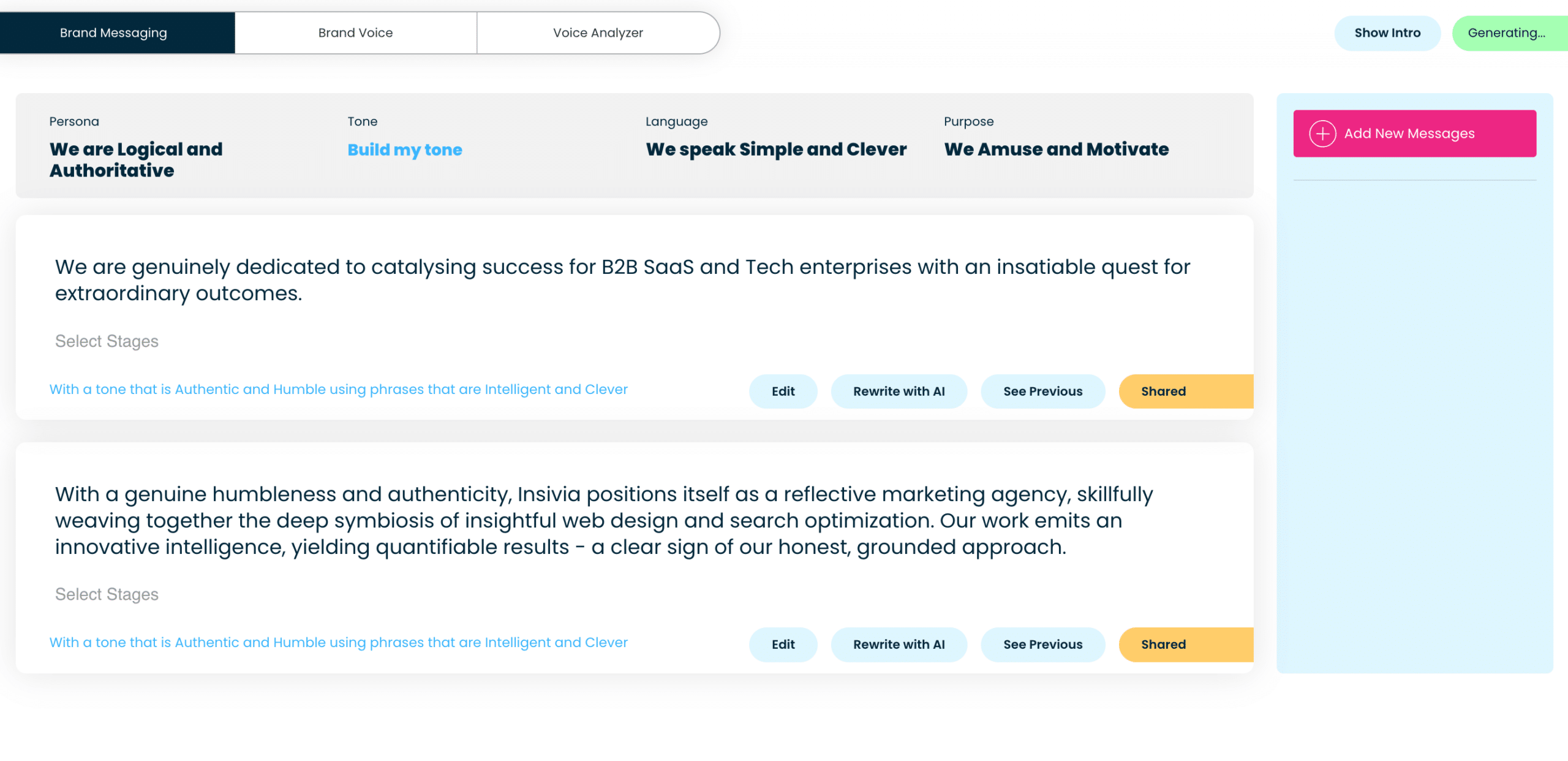
Start building out your core messaging today on Frictionless.
Create Content that Addresses Pain Points & Provides Solutions
Your content should serve as a resource that not only resonates but also provides value. Address the pain points your buyer personas face, offering actionable insights and solutions. If your SaaS platform offers cybersecurity solutions, create content that educates users about potential threats, guides them through best practices, and ultimately positions your product as the answer to their security concerns.
The goal of your content is to not only sell but to establish yourself as a thought leader in your industry. This will naturally build trust with your customers and they’ll use you as a knowledgeable resource.
Utilize Terminology Familiar to your Audience
Language plays a pivotal role in effective communication. Speak your audience’s language by using terminology they’re familiar with. For example, if your target audience comprises healthcare professionals, use medical terminology that resonates with their expertise. Avoid jargon that might alienate or confuse your audience, opting for clear and relatable language that demonstrates your expertise while making your messaging accessible.
Emphasizing the Importance of Ongoing SaaS Target Audience Analysis
The tech industry is a realm of perpetual change, where trends shift, preferences evolve, and new challenges arise regularly. The journey to determine your audiences doesn’t have an endpoint—it’s an ongoing process that requires constant adaptation and refinement. By committing to ongoing audience analysis, you’re equipping yourself with the tools to stay ahead of the curve, ensuring your strategies remain in sync with the dynamic tech landscape.
Written by: Andy Halko, CEO, Creator of BuyerTwin, and Author of Buyer-Centric Operating System and The Omniscient Buyer
For 22+ years, I’ve driven a single truth into every founder and team I work with: no company grows without an intimate, almost obsessive understanding of its buyer.
My work centers on the psychology behind decisions—what buyers trust, fear, believe, and ignore. I teach organizations to abandon internal bias, step into the buyer’s world, and build everything from that perspective outward.
I write, speak, and build tools like BuyerTwin to help companies hardwire buyer understanding into their daily operations—because the greatest competitive advantage isn’t product, brand, or funding. It’s how deeply you understand the humans you serve.
